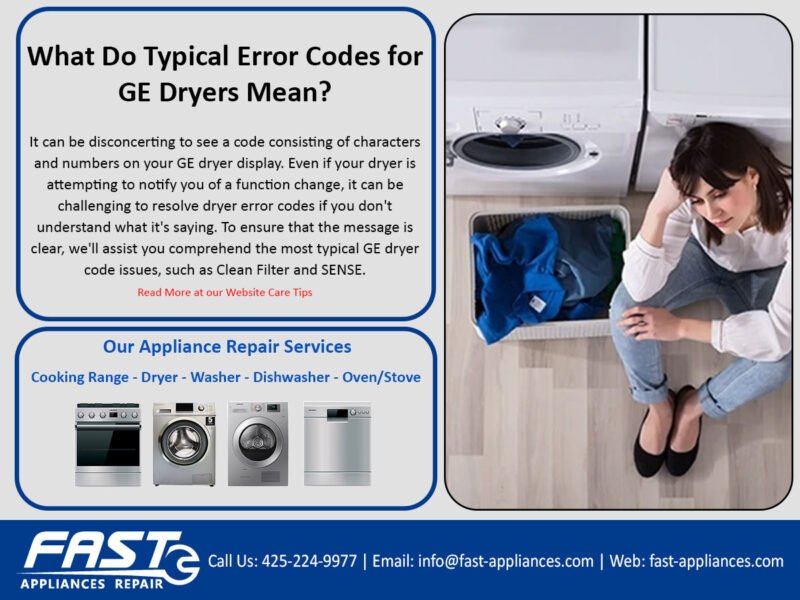
The E3 error code is a signal from your GE dryer indicating an issue that needs attention. While it might sound technical, think of it as the dryer’s emergency call, much like how your car’s engine light tells you to check under the hood. In this case, the E3 code often points to a problem with the drive motor or a jammed drum. But don’t worry, understanding this issue doesn’t require a degree in engineering. Let’s break it down together so you’ll know when it’s time to call in the pros.
Understanding the E3 Error Code
An E3 error code might seem cryptic at first, but understanding its core meaning is simpler than you might think. In essence, it’s your dryer letting you know there’s a mechanical issue that it can’t fix on its own. So, how does this happen? Well, it’s usually related to the drive motor. This part is like the heart of your dryer, pumping power to make the drum spin and effectively dry your clothes. When it’s blocked or malfunctioning, the E3 code pops up as a distress signal.
It’s important to remember that this isn’t something you’ve done wrong. Machines, like people, sometimes experience hiccups, and the E3 is simply a symptom that something inside needs checking. Perhaps the motor is struggling because of a jam, or it might be overheating due to a mechanical fault. Whatever the reason, the E3 code is there to ensure you’re aware that the machine isn’t running optimally.
Suppose you ignore this code. In that case, it’s like ignoring a warning light in your car—it might work for a bit longer, but you could be setting yourself up for bigger problems down the line. This is why understanding and responding to the E3 error promptly is crucial to maintaining the longevity and efficiency of your dryer.
Why Does the E3 Error Happen?
You’re probably wondering, why does this E3 error occur in the first place? Well, the reasons can vary, but they often boil down to a few common culprits. One usual suspect is a jammed dryer drum. Imagine trying to turn a wheel that’s stuck; no matter how much force you apply, it’s not going to spin smoothly. Similarly, when clothes or other items get caught in the drum, the motor can’t function properly, leading to the E3 warning.
Another possibility is an issue with the drive motor itself. The drive motor is like your dryer’s athlete, tirelessly spinning the drum so your clothes can dry. But over time, this part can wear out or develop faults, especially if your dryer is an older model or frequently used. This wear and tear can lead to overheating or mechanical failure, triggering the dreaded E3 code.
Lastly, electrical issues can sometimes be the hidden villain. A problem with the wiring or connections within your dryer can intermittently cut power to the motor, causing erratic functioning and, you guessed it, an E3 error. Electricity is the lifeblood of your appliances; when there’s a disruption, the effects can ripple throughout the machine’s operations.
Should You Try Fixing It Yourself?
Now, you might be tempted to roll up your sleeves and tackle the E3 error head-on. After all, do-it-yourself fixes can be satisfying and saving a few bucks is tempting. However, here’s the deal: while some home repairs are totally within the realm of DIY, dealing with a motor issue in a dryer can be a bit more complex, especially if you’re not accustomed to handling electrical components.
Sure, checking for obvious blockages in the dryer drum is a straightforward first step. If you find a tangled mess of clothes or a lodged item, removing it might solve the problem. But if the issue relates to the drive motor or electrical components, it’s usually wise to call a professional. Attempting to dismantle or repair these parts without the proper know-how can lead to further damage or even safety hazards.
Think of the technician as a doctor for your dryer. They have the tools and expertise to diagnose the issue correctly and perform the necessary repairs. It’s a bit like taking your car to the mechanic when there’s a strange noise—you could try and fix it, but isn’t it reassuring to have an expert’s opinion?
Preventative Measures and Next Steps
No one likes dealing with unexpected appliance issues, so what can you do to prevent the E3 error from occurring in the future? First, maintaining a clear and uncluttered dryer drum is key. This way, you avoid jams that can cause the motor to stall. Always check your pockets before washing to ensure no small items end up in the drum.
Regular maintenance can also play a crucial role. Periodically cleaning the lint filter and ensuring proper airflow around your dryer can help keep the motor from overheating. Think of this like routine check-ups at the dentist—preventative care can avert major issues down the line.
If the E3 error has already reared its head, the next step is to contact a GE-certified technician. Armed with their expertise, they can diagnose the issue accurately, whether it’s a simple blockage or a more serious motor malfunction. You’ll gain peace of mind knowing that your dryer is in good hands, allowing you to get back to more enjoyable activities than worrying about appliances.
By understanding the E3 error code and knowing when to call a technician, you’re not just solving a problem—you’re taking proactive steps to extend the life of your dryer. And who doesn’t love fresh, warm clothes without the drama of an error code?